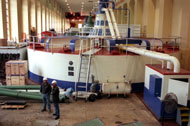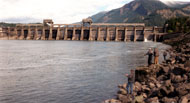forum
library
tutorial
contact

Columbia's Power:
The River Contains the Secret
to Drive a National Energy Revolution
by Jack Robertson
The Register-Guard, February 16, 2003
|
the film forum library tutorial contact |

|
Columbia's Power:
by Jack Robertson
|
THE MIGHTY Columbia River's nighttime flow holds a remarkable secret. This secret can put the Northwest at the center of a global energy revolution, create thousands of new jobs and help end forever our dependence on Middle East oil.
While you sleep, the power of the Columbia River can create a revolutionary new energy source - lighter than air, completely renewable, and yet with the highest energy content of any fuel. In the Northwest we can produce this new fuel faster, cleaner and cheaper than anywhere in the world. What's its source?
Water.
 That's right. The power of the Columbia River can unlock hydrogen from water. It can turn the Northwest into the Saudi Arabia of hydrogen - the revolutionary fuel at the center of President Bush's bold, $1.2 billion proposal to build hydrogen-powered cars and a national hydrogen infrastructure.
That's right. The power of the Columbia River can unlock hydrogen from water. It can turn the Northwest into the Saudi Arabia of hydrogen - the revolutionary fuel at the center of President Bush's bold, $1.2 billion proposal to build hydrogen-powered cars and a national hydrogen infrastructure.
For centuries, people have dreamed of a limitless, clean source of energy. For decades, scientists have known that hydrogen - the most common element in the universe - holds the answer to a global energy revolution.
Critics insist hydrogen-powered cars are at best a decade away, that a national hydrogen infrastructure is impractical, that hydrogen costs too much, and that consumers will consider it unsafe.
But now the world faces grave economic, environmental and foreign policy dangers - all linked to energy. We need a fundamental breakthrough, the energy equivalent of the computing revolution of the last 20 years, to solve these problems. Hydrogen holds the key to a radical break from the past. It's time the critics were answered.
We can start right here. Hydrogen produced at night and stored in fuel tanks throughout the Northwest can revolutionize energy consumption in the 21st century. The end of the age of oil can begin here.
Most importantly, you don't have to wait a decade or more to drive a hydrogen-powered car - it can power the minivan or SUV sitting in your garage. Hydrogen is 50 percent more powerful than gasoline. It can increase the horsepower of your existing car, take you hundreds of miles on a single tank, and never require a tune-up.
With existing technology, your car can be retrofitted to run on both gasoline and hydrogen. It will require basically three things; a new fuel tank, new spark plugs and a few hours in a local car shop. Today, a retrofit will probably cost a few thousand dollars - until dual-fuel hydro cars become popular. The price should drop, and you should be able to order a dual-fuel car from the factory.
With our natural, hydrogen-producing resource, the Columbia River, we can put thousands of these cars on Northwest roads within a handful of years. Our economy will strengthen even as our skies clear.
The secret to our success will be found in a simple equation. We can produce hydrogen from water as cheaply as big oil companies can produce gasoline from oil.
How? Through water power.
At night and during the spring runoff, the Columbia River produces huge amounts of very low-cost electricity that can be sent to municipal fueling yards and gas stations region-wide. The electric current runs through water in an electrolyzing machine about the size of a refrigerator. There, electricity splits water into its two fundamental components - hydrogen and oxygen gas.
 Oxygen is put in tanks and sold to hospitals. The hydrogen gas is safely stored on site in a large propane-like tank. Right now, hydrogen test stations are already fueling cars in California, Las Vegas and Phoenix. In the future you will pull up to the hydrogen fueling station, attach the nozzle to your tank, and swipe your credit card. Hydrogen gas will be automatically pumped into your upgraded car. Two minutes later the computer shuts off the valve, and your tank is full.
Oxygen is put in tanks and sold to hospitals. The hydrogen gas is safely stored on site in a large propane-like tank. Right now, hydrogen test stations are already fueling cars in California, Las Vegas and Phoenix. In the future you will pull up to the hydrogen fueling station, attach the nozzle to your tank, and swipe your credit card. Hydrogen gas will be automatically pumped into your upgraded car. Two minutes later the computer shuts off the valve, and your tank is full.
You pull away and - presto - you are transformed from a gas-guzzling commuter into a powerful force for change. You're now driving a hydro car - a car that runs on hydrogen made from water. You have become a cutting-edge consumer, a powerful environmentalist, and a leader for U.S. energy independence - all by driving the kids to school.
There are three crucial steps to building the infrastructure to support thousands of hydro cars in the next few years.
Step one will require that we turn water into low-cost hydrogen. Technology to turn water to hydrogen - hydro fuel - exists right now. Most of the infrastructure is already built. The Northwest has 40 percent of the nation's hydroelectric power. Electricity is sent out over the existing power grid to every big city and small town in the Northwest. Electrolyzing machines are off-the-shelf technology.
The electrolyzing machine transforms tap water into hydrogen. The energy content from the hydrogen in a gallon of water equals 10 gallons of gasoline. Most remarkably, when hydrogen is burned in your car engine its only exhaust is water vapor. This vapor returns to the atmosphere, producing rain and replenishing our rivers. Hydrogen becomes a perpetual fuel - power from a perfect natural cycle.
Not only is it clean, it can be very cheap.
At night while we sleep, demand for electricity ebbs. The wholesale price of electricity drops to about 2 cents a kilowatt hour. During the massive spring runoff, the price drops even further - to less than 1 cent a kilowatt hour even in low water years. Experts say it takes 38 kilowatt hours of electricity to produce the hydrogen equivalent of a gallon of gas.
At 2 cents a kilowatt hour, hydrogen gas equal to a gallon of gasoline would cost 76 cents. At a spring price of 1 cent a kilowatt hour, the cost of producing hydrogen fuel equal to a gallon of gasoline drops to 38 cents. Even with retail mark-ups and added energy used for compressing hydrogen into the station's fuel tank, the cost of producing hydrogen here should be competitive with gasoline.
Some would consider this calculation conservative. It assumes no benefit from selling oxygen to hospitals. Nor does it include benefits from a new power source centered in this country. We now pay billions to nations in the Middle East and elsewhere for the basic source of energy - oil. The electricity prices we will pay for producing hydrogen will go instead to local utilities, helping keep overall transmission and electric power rates low. This strengthens our economy.
Hydrogen revenues also will strengthen the Bonneville Power Administration, which provides half the region's electricity and funds the world's largest fish and wildlife program on the Columbia River. Finally, large-scale hydrogen production will increasingly free us from the political turmoil in oil-rich regions of the world. Given the threat of terrorism and war, this benefit is - as they say in the commercial - priceless.
Early-stage costs of hydrogen fueling stations, if added to the cost of producing pure hydrogen, could push hydrogen's price above the price of gasoline in the near term. But as demand for hydrogen increases, the cost of producing this infrastructure should drop rapidly.
Cost is just one factor. Just imagine the enormous long-term environmental and human health benefits of a practical, powerful, zero-emissions fuel. Gasoline-powered cars account for half the oil consumed in the United States, half the urban pollution, and one-forth the greenhouse gases. Hundreds of millions of tons of carbon monoxide, nitrogen oxide, and other chemical pollutants would be eliminated every year. Pollution alert days could disappear forever in the rear-view mirror of history.
Step two is to convert your car. This can be simple.
The internal combustion engine in your car can run on hydrogen or gasoline. It doesn't care. New injectors, capable of handling both hydrogen and gasoline, will replace spark plugs. A new hydrogen fuel tank is under consideration by the federal Department of Transportation. With it, a hydrogen-powered car can travel 200 miles before refilling. Tanks on the drawing board can extend that range up to 1,000 miles.
With two tanks, your car can run on hydro fuel until its empty. Then you switch your engine to gasoline with the flip of a switch, extending your car's range by hundreds of miles. As the "hydrogen highway" expands and tanks improve, gasoline can be phased out.
Car safety is a vital issue. Because we've all heard of hydrogen bombs, some consumers are frightened of putting such an explosive material in the tank of their car. This fear is understandable, but exaggerated. A hydrogen bomb, for example, can be triggered only by the heat of an atomic bomb.
Hydrogen fuel burns a lot like the natural gas fueling some buses today - only faster and cleaner. Because it is lighter than air, if a tank of hydrogen gas is broken in an accident, the flames will burn straight up - away from passengers.
The rupture of a car tank filled with hydrogen can pose less danger to passengers than a tank filled with gasoline.
Step three is to create a hydrogen highway.
A public-private consortium should select key rural and urban markets to create an initial network of fueling stations.
This project will form the initial backbone of a new hydrogen infrastructure, linking up to existing stations on the West Coast and expanding with demand.
The hydrogen in tanks region-wide can serve another purpose. During emergencies, electricity-generating turbines can be powered by the stored hydrogen gas.
This keeps the lights on with a nonpolluting source of electric energy - right in our neighborhood. This can save hundreds of millions of dollars in electric grid expansion projects.
Our regional economy needs help. Global oil-based energy markets are unstable and threatened by terrorism. Worldwide, demand for energy far outstrips supply - condemning billions to a life of grinding poverty with no lights, no heat and no future. Carbon-based pollution adds to a threatened global environment.
The sheer magnitude of these challenges demands a fundamental energy breakthrough - a new, hydrogen-based economy to power the 21st century. With the enormous power of the Columbia River, the Northwest enjoys a huge natural advantage in a hydrogen future. We can help lead the nation and the world away from the carbon-based economy of the last century and toward an energy revolution fueled by water.
We need to unlock the river's powerful secret - now.
learn more on topics covered in the film
see the video
read the script
learn the songs
discussion forum
